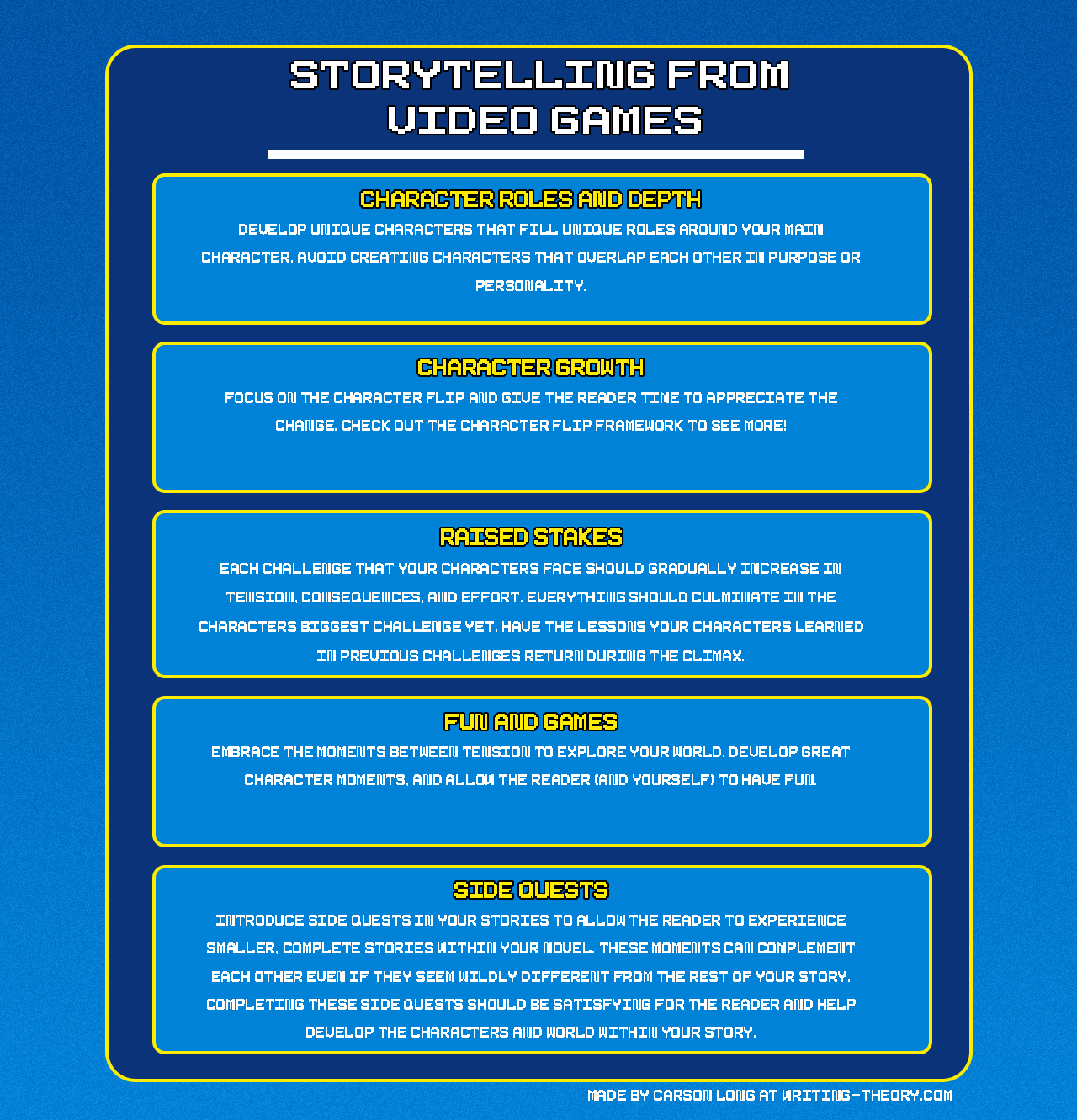Let’s keep this one short and to the point.

Lesson 1 - Character Roles and Depth
A story-driven Video Game can take a hundred hours of more for a player to finish. In that time, the player is surrounded by characters. These characters must do two things:
First, they must fill certain roles. If each character is mean to be the supportive friend to the main character, then the main character is never challenged. Conflict is introduced when the main character is surrounded by characters that have different outlooks, fears, and desires.
Second, they must have depth. The sheer amount of time that the player is exposed to side characters means that these side character must have a lot to uncover. This means that side characters in games naturally have depth that is teased out through gameplay and interaction.
Apply this to your writing to ensure that the characters within your story fill unique roles that allow you to explore conflict through interesting perspectives. Spend time developing your side characters to understand how and why they work. Even if that detail is never presented in your story, it means that you will have a much better understanding when writing them.
Lesson 2 - Character Growth
The character flip, explored here, is a framework of ensuring that a character has their worldview challenged through your story, struggles to adapt, and finally gives up their worldview for a change.
If a story causes no change, then what was the point?
We, as readers, want to see the characters face hard decisions and grow. Video Games do this through storylines for each major side character. This gives us, the player, a chance to understand why they are the way that they are. Then, as that storyline progresses, we see their storyline challenge their beliefs and the side character make a change. Shadowheart in Baldur’s Gate 3, anyone?
Lesson 3 - Raised Stakes
This comes so naturally in Video Games. How many games begin the story with our hero killing rats in some basement and concludes the story with the hero killing some god? Fable? Bard’s Tale? So many classic fantasy video games take this route. And, even game that are not fantasy.
Action games, and shooters, like Halo or Doom, start the game by giving you a pistol (or other simple weapon). As the game progresses, you gather more and more weapons into your arsenal. Shotguns, Rocket Launchers, Lasers, and more.
Raising Stakes in Video Games keeps things fresh and engaging for the player. It does the same for the reader. It ensures that there is always something on the line and a reason to be nervous about what comes ahead.
Your novels should introduce harder and harder challenges to your characters. Ideally, these challenges should test the character and leave them with some lesson learned that they apply to future challenges. The climax of your story is the culmination of all of these lessons learned and brings everything full circle.
Lesson 4 - Fun and Games
One of my favorite parts of games is when I’m given the chance to experience the world. Games spend so much effort in creating this world that it would be a shame to never get a chance to explore it. This doesn’t just apply to open world games, but any game that wants to make you feel lost in the experience.
Give your characters (and reader) the chance to breath and have some fun. These moments can become great moments of character and world building. Pair up characters that normally don’t get along well and put them in a place where they are forced to interact. Give two characters with a budding romance a chance to leave the main plotline and just have a moment together. These fun and games moments are fan-service and leave the reader feeling rewarded for investing themselves into the story.
Lesson 5 - Side Quests
Just like with Fun and Games, not every moment of a story needs to be focused on the main storyline. Doing so can lead to exhaustion and overdose. Variety is the spice of life, so introduce some smaller side quests that operate like full stories themselves to explore different kinds of storytelling.
Video Games use side quests to slow the player down and let them experience more than the big, dramatic story. It gives the game a chance to explore something with more comedy or somberness or flair then what is already presented through the main story.
In writing, you have limited time, space, and word count. But, you can still use Side Quests! Create these smaller storylines within your novel to explore different kinds of stories. If each Side Quest can also contribute to the progression of your character journeys, character flips, and main storyline; then you have something special that embraces the variety with no wasted space.
